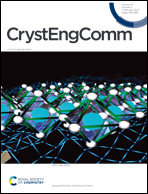Exploration of Cl⋯Cl and π⋯π stacking contacts along with the conductivity properties of a Cu-MOF featured with paddle-wheel SBUs†
Abstract
A Cu(II)-based metal–organic framework (MOF) [Cu(muco)(3,5-DCP)]n (1) has been synthesized by using linear rigid aliphatic dicarboxylic acid, trans,trans-muconic acid (H2muco) and 3,5-dichloropyridine (3,5-DCP) as an auxiliary ligand. The MOF adopts a square-grid two-dimensional (2D) structure with paddle-wheel [Cu2(OOC)4] robust secondary building units (SBUs). The 3,5-DCP ligands are perpendicularly projected from the SBUs at both sides and undergo interdigitation via antiparallel π⋯π stacking interactions among 3,5-DCP ligands to fabricate three-dimensional (3D) supramolecular architecture. The π⋯π interactions favour the formation of Cl⋯Cl stacking contacts. These non-covalent interactions are further validated by density functional theory (DFT) calculation. In addition, the synthesized MOF is tested for conductivity measurements via current density–voltage characteristics, as well as impedance spectroscopy, which reveal that the MOF is semiconducting in nature and can be used as a Schottky diode.



 Please wait while we load your content...
Please wait while we load your content...